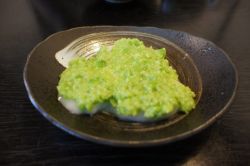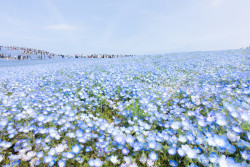
October 15, 2009
Ashibina
Get that fresh-off-the-boat feeling again at this Okinawan eatery
By Metropolis
Originally published on metropolis.co.jp on October 2009

Photo by Fritz Schumann
Old Japan hands can boast of their expertise in culinary linguistics, easily differentiating menchi from tonkatsu or discoursing on the relative merits of chu-toro and o-toro. The truly knowledgeable can even tell you what konnyaku is actually made of. But when the been-there, tasted-that feeling gets to be too much, a quick jaunt over to a place like Ashibina will make you feel like a tourist again.
Located in a busy, izakaya-filled side street near Ikebukuro’s east exit, Ashibina proudly proclaims its Okinawan origins with a display of clay statues of strange, doglike creatures. The animals, we learn, are called shisa, a version of the Chinese lion/dog often found outside Okinawan homes to guard against evil spirits. As you’d expect from an island-themed joint, the interior is colorful and friendly, with several tables dotted about and a corner devoted to casual zashiki style seating.
Opening the menu was the first big adventure of the evening. While we did spot some familiar dishes like goya chanpuru and Spam, for the most part it was page after page of words like mimigaa and hirayachi. Even the drinks menu was not without its surprises. Of course, there were the expected brands of awamori, the signature liquor of Okinawa (by way of Thailand, incidentally) plus several awamori cocktails (¥630). In an interesting touch, each of the sours is available with either an awamori or shochu base. We went for the local stuff mixed with sanpin (¥525) and shikuwasa (¥578). The former is a jasmine-flavored green tea prized for its health benefits, while the latter is a citrus fruit often described as a cross between a tangerine and grapefruit or lime. Both drinks were quite refreshing, but stay away from shikuwasa if you like your fruits sweet and mild.

Photo by Fritz Schumann
We started our meal off with an appetizer of jimami-dofu (¥525), a tofu made from peanuts with a surprisingly gummy, gelatin-like texture that paired well with the sweet, nutty sauce drizzled over it. And of course, we knew we couldn’t leave without trying that infamous Okinawan specialty, goya chanpuru. Ashibina’s version has tofu, egg, moyashi and ham, in addition to the goya, and comes in small (¥578) and medium sizes (¥1,082). We opted for the small—a fortunate decision, since while we rather enjoy the goya’s bitter taste, our companion wasn’t so keen.
We finished off our meal with that other local specialty, yakisoba made with Okinawan “soba” noodles, which are closer to ramen or udon than to true buckwheat soba. At Ashibina, the dish comes in salt, sauce and “Neapolitan” versions (¥714). Feeling a little adventurous, we chose the latter. Like the pasta dish of the same name, it has a tomato-based sauce that goes oddly well with the ham and goya. The noodles themselves are also grilled slightly crispier than your average yakisoba, giving them an interesting texture.
We took our leave, unfortunately, just as it looked like things were starting to get interesting, with a rowdy party occupying the other half of the restaurant. But a quick glance at the flyer advertising Ashibina’s periodic live music nights had us resolved to make another trip in the near future.







